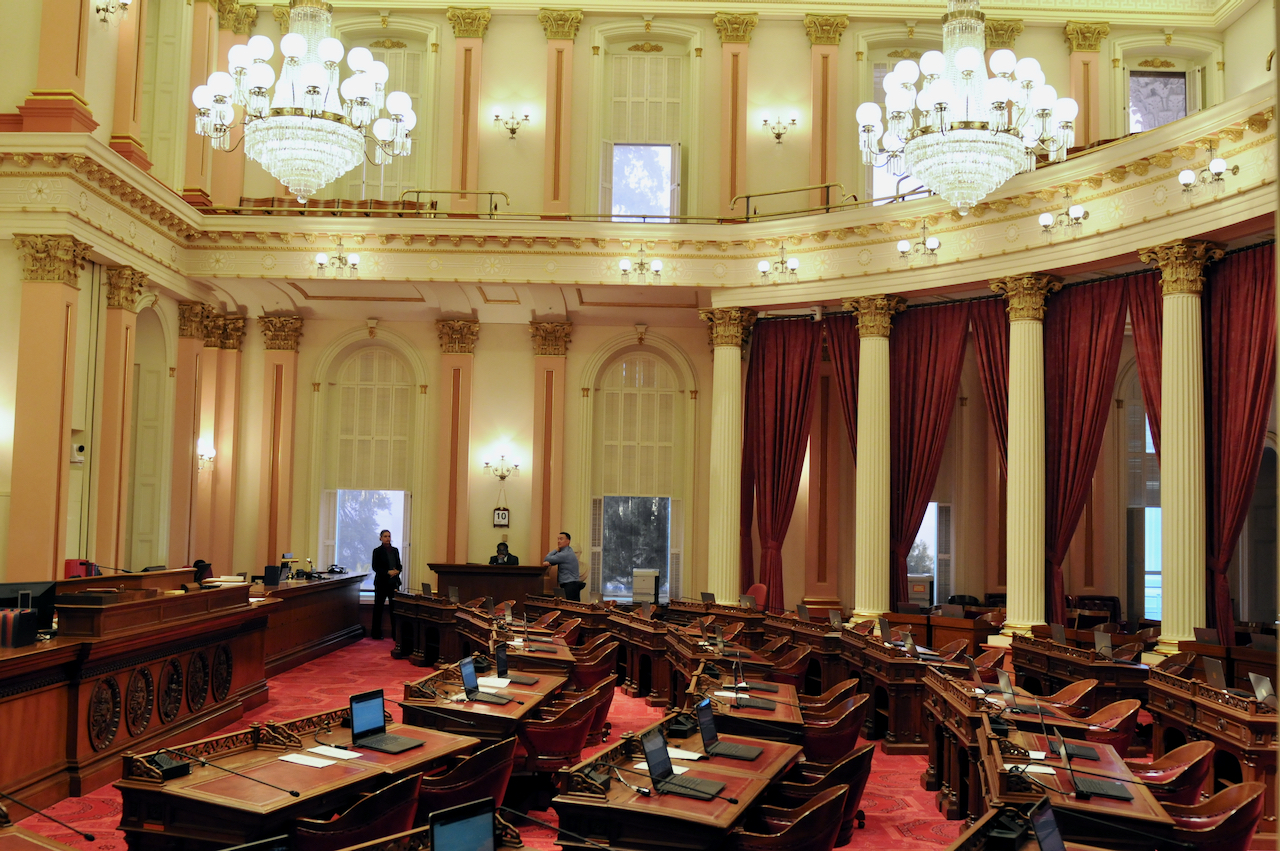
The Legislative Bill Room, California State Capitol. (Photo: ca.gov)
How to Read a California Bill Analysis
Who supports and opposes the measure?
By Chris Micheli, December 28, 2023 2:30 am
As you might think, there are several different types of bill analyses used in the California Legislature. First, there are committee and floor analyses of bills. Second, at the committee level, there are analyses prepared by the policy and fiscal committees. These different types of analyses serve different purposes for different audiences.
In most instances, the most substantive analyses are prepared by the policy committees in the Assembly and Senate. Nonetheless, even these can differ significantly between short versions (typically 3-4 pages in length) and long versions (sometimes reaching 20-25 pages or more). The fiscal committee analyses, focused obviously on the fiscal impacts of bills, are typically 1-3 pages in length. Floor analyses can be a few pages to many pages in length.
Each of these analyses are necessary to address critical aspects of the bills that are being analyzed by the policy and fiscal committees. And, they are designed for their audiences – legislators, staff, advocates, and the general public, all of whom are concerned with either the policy or fiscal implications of a bill.
In addition, readers should be aware that the Democratic and Republican Caucuses in both the Senate and Assembly prepare their own, private analyses for their respective party members. These usually contain summaries of the key provisions of a bill, comments that may be in line with party ideology, and listings of proponents and opponents of the bill.
Between committee and floor analyses, most bill analyses produced for the floor of the Assembly or Senate usually are shortened versions of a combined policy and fiscal analysis. They address in summary fashion the key policy and fiscal aspects of the bill. There are a few differences between how the Assembly and Senate prepare their floor analyses. For example, one of the most often cited differences is that the Senate floor analysis includes a list of supporters and opponents of the bill, while the Assembly version does not.
So, how should you read a bill analysis in the California Legislature?
All committee analyses reference critical information at the top: Name of the committee, hearing date, bill number and author, subject matter, vote requirement, and version (introduced or amended) that is being analyzed. Thereafter, these analyses provide relevant information for the reader.
In most instances, policy committee analyses address the following questions:
- What is existing law in this subject area?
- What is the intent behind the proposed legislation?
- What does the legislation propose to do?
- Does it create new rights or benefits?
- Does it prohibit, regulate or impose obligations?
- Does it authorize or permit conduct?
- Does it apply prospectively or retroactively?
- What are the arguments for and against the bill?
- Who supports and opposes the measure?
In preparing a legislative bill analysis, committee consultants first read the bill and identify the key information contained in the bill, which will then be set forth in their analysis. This provides valuable information for the reader of the analysis. For California bills, the first page or two of a bill contains the following information:
- Bill number
- Bill’s author
- Date of introduction
- Date of each amendment
- Added, amended, or repealed code sections
- Vote requirement for bill’s passage
- Fiscal implications of the bill
- Whether there is any state-mandated local cost.
The introduction or amendment date is noted in the analysis because each time a bill is amended, the language changes and reference are always made to the date of the amended version when describing the bill’s version and referring to its provisions as the bill analyses must be completed based on the most recent version of the bill.
Staff usually read the Legislative Counsel’s Digest, which first sets forth existing law in the subject matter, and then provides a brief summary of the changes a proposed bill will make to current law, if adopted. Committee staff do not rely on this summary as their primary source of information. Instead, they read and thoroughly understand the actual bill language as only the bill language will become law.
Look in the committee analysis for relevant statements of legislative intent from the bill. It is usually replicated in the bill analysis and many analyses actually provide a section titled “author’s statement,” for example. This can help guide those who must comply with the new law or the law changes made by the bill, as well as for courts to make determinations in future litigation about was intended by the bill. Legislative intent can guide interpretation and implementation of a particular statute, especially when a bill is lengthy, complicated or, in some cases, ambiguous. As a result, focus on this section when reading the analysis.
Often these analyses identify any language in a bill that elaborates on the purpose or goals of proposed legislation to help understand the context and purpose of the bill. Legislative intent can sometimes be found at the beginning of the bill in such phrases as “it is the intent of the Legislature to do the following…” or “the Legislature finds and declares…” However, there may not always be such explicit statements of intent in the bill.
Committee consultants will also consult statements in support of or in opposition to the bill, as well as other relevant analyses of the measure, such as those prepared by a state agency or department or a committee in the other house. The analysis may also rely upon press releases, written testimony, or other sources that staff obtain. They also review in detail the letters of support and opposition, any reports or studies, and other relevant materials regarding the bill being analyzed so that these sources of information can be identified in the analysis.
When reviewing the bill’s provisions, note any statements imposing requirements, prohibiting or permitting conduct, and other relevant provisions. The bill analysis will discuss these statements and this will help the reader determine to whom its provisions apply. In this regard, the bill analysis will help answer questions such as:
- What action is required?
- What action is prohibited or permitted?
- Who is impacted by the bill?
The committee analysis will usually clearly and thoroughly discuss existing law that is being amended or repealed, and what impact the bill would have on existing law if it were enacted. The analysis will identify substantive changes to the law, noting in particular words such as “may” or “shall.”
When committee consultants are analyzing a bill, their written analysis describes the circumstances surrounding the need for the bill, such as what led to its introduction, whose interests are being represented, and the goals of the legislation. The purpose of understanding the context of the bill will enables the reader of the analysis to appreciate the critical question of what problem the legislation is attempting to address in this particular bill.
After setting forth the specific provisions of the proposed legislation, those reading the analysis will find additional information that explains the background of the measure. For example, the analysis may address questions such as the following:
- Are there any applicable court decisions?
- Have there been previous efforts to pass similar legislation?
- If so, what happened to those bills?
- Was the language the same, similar or different in those prior bills?
Some committee analyses include “comments” that are offered by the committee consultant analyzing the bill. These may raise important policy or fiscal considerations that legislators should consider before voting on the bill. In the comments section, there may also be suggested technical amendments, or suggested definitions, or other proposed amendments that should be considered.
Finally, the policy committee analyses (but not the fiscal ones) provide a list of the supporters and opponents of the bill, as well as a summary of the proponents’ and opponents’ arguments. Often the committee consultant will quote from one or more support and opposition letters. It is important for legislators, staff, and the public to know the arguments pro and con on the particular bill and which groups are in favor and against a bill.
Finally, readers should be aware that there are bill analyses that are prepared by California agencies and departments, including the Department of Finance (DOF). Note, however, that these analyses only become public after the Governor’s Office authorizes a position to be made public.
These state governmental entity analyses usually follow this format:
- Summary;
- Reason for the Bill;
- Analysis – Existing Law;
- Analysis – This Bill;
- Legislative History;
- Program Background;
- Other State’s Information;
- Fiscal Impact;
- Support;
- Opposition; and,
- Arguments – Pro and Con.
Writing legislative bill analyses is a critical component of the legislative process because these analyses explain the substance of what is contained in proposed legislation so that legislators, their staff, interest groups, advocates, and members of the public can be aware of proposed law changes. While there are different types of bill analyses, they all serve the same function – to inform interested parties and decision-makers.
- Should Interpretive Guidance Be Included in California Legislation? - April 28, 2024
- Legislative Intent Does Not Equate to a Mandate - April 27, 2024
- Frequently Asked Questions about State Agency Ethics Training - April 26, 2024




